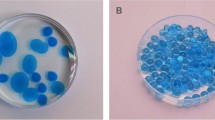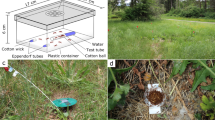Abstract
The Argentine ant, Linepithema humile (Mayr), poses a significant economic threat to citrus production in southern California. Broad-spectrum insecticide sprays provide poor ant control and present a hazard to human and environmental health. Liquid sucrose bait infused with a low concentration of insecticide is an effective alternative treatment but current approaches require considerable economic investment in plastic dispensers and continual maintenance. To produce a baiting product for control of L. humile suitable for large-scale application, a biodegradable, broadcastable alginate hydrogel for delivery of aqueous low-dose thiamethoxam sucrose bait was developed and evaluated in replicated field trials in commercial citrus groves. Ant activity was significantly reduced in hydrogel-treated trees. Peak L. humile suppression was achieved 48 h following the final hydrogel disbursement, with an estimated 91% reduction in activity from baseline estimates and a 17-fold lower activity in treated trees in comparison with untreated trees. Significant residual activity of the hydrogel treatments was recorded, with a nearly 70% reduction from pre-treatment levels persisting at least 3 weeks after the last application. We conclude that alginate hydrogels can provide excellent control of L. humile while deploying 99.99% less insecticide into orchards than commercial barrier spray treatments.


Similar content being viewed by others
References
Abril S, Oliveras J, Gómez C (2014) Foraging activity and dietary spectrum of the Argentine ant (Hymenoptera: Formicidae) in invaded natural areas of the northeast Iberian Peninsula. Environ Entomol 36:1166–1173
Agosti D, Majer JD, Alonso LE et al (2000) Ants: standard methods for measuring and monitoring biodiversity. Smithsonian Institution Press, Washington DC, pp 1–280
Babcock B (2018) Economic impact of California’s citrus industry. Citrograph 9:36–39
Bellows TS Jr, Morse JG (1988) Residual toxicity following dilute or low-volume applications of insecticides used for control of California red scale (Homoptera: Diaspididae) to four beneficial species in a citrus agroecosystem. J Econ Entomol 81:892–898
Blacquiere T, Smagghe G, Van Gestel CA, Mommaerts V (2012) Neonicotinoids in bees: a review on concentrations, side-effects and risk assessment. Ecotoxicology 21:973–992
Boser CL, Hanna C, Holway DA et al (2017) Protocols for Argentine ant eradication in conservation areas. J Appl Entomol 141:540–550
Buckley RC (1987) Interactions involving plants, Homoptera, and ants. Annu Rev Ecol Syst 18:111–135
Buczkowski G, Roper E, Chin D (2014a) Polyacrylamide hydrogels: an effective tool for delivering liquid baits to pest ants (Hymenoptera: Formicidae). J Econ Entomol 107:748–757
Buczkowski G, Roper E, Chin D et al (2014b) Hydrogel baits with low-dose thiamethoxam for sustainable Argentine ant management in commercial orchards. Entomol Exp Appl 153:183–190
California Department of Pesticide Regulation (2019a) California acts to prohibit chlorpyrifos pesticide. https://www.cdpr.ca.gov/docs/pressrls/2019/050819.htm. Accessed 17 May 2019
California Department of Pesticide Regulation (2019b) Chlorpyrifos interim recommended permit conditions. https://www.cdpr.ca.gov/docs/enforce/compend/vol_3/append_o.pdf. Accessed 20 Mar 2019
Cooper M, Daane K, Nelson E et al (2008) Liquid baits control Argentine ants sustainably in coastal vineyards. Calif Agr 62:177–183
Cooper ML, Hobbs MB, Boser CL et al (2019) Argentine ant management: Using toxin-laced polyacrylamide crystals to target ant colonies in vineyards. Catal Discov Pract 3:23–30
Daane KM, Cooper ML, Sime KR et al (2008) Testing baits to control Argentine ants (Hymenoptera: Formicidae) in vineyards. J Econ Entomol 101:699–709
Environmental Protection Agency (2010) Toxicological review of acrylamide CAS. https://cfpub.epa.gov/ncea/iris/iris_documents/documents/toxreviews/0286tr.pdf. Last accessed 17 May 2019
Environmental Protection Agency (2016) Chlorpyrifos revised human health risk assessment. https://www.regulations.gov/document?D=EPA-HQ-OPP-2015-0653-0454. Accessed 20 Mar 2019
Erkekoglu P, Baydar T (2014) Acrylamide neurotoxicity. Nutr Neurosci 17:49–57
Greenberg L, Klotz JH, Rust MK (2006) Liquid borate bait for control of the Argentine ant, Linepithema humile, in organic citrus (Hymenoptera: Formicidae). Fla Entomol 89:469–474
Hanna C, Naughton I, Boser C et al (2015) Floral visitation by the Argentine ant reduces bee visitation and plant seed set. Ecology 96:222–230
Hogg BN, Nelson EH, Hagler JR, Daane KM (2018) Foraging distance of the Argentine ant relative to effectiveness of a liquid bait control strategy. J Econ Entomol 111:672–679
Kistner EJ, Lewis M, Carpenter E et al (2017) Digital video surveillance of natural enemy activity on Diaphorina citri (Hemiptera: Liviidae) colonies infesting citrus in the southern California urban landscape. Biocontrol 115:141–151
Klotz JH, Rust MK, Gonzalez D et al (2003) Directed sprays and liquid baits to manage ants in vineyards and citrus groves. J Agric Urban Entomol 20:31–40
Knight RL, Rust MK (1990a) Controlling Argentine ants in urban situations. In: Vander Meer RK, Jaffe K, Cedenmo A (eds) Applied myrmecology: a world perspective. Westview, Boulder, pp 663–670
Knight RL, Rust MK (1990b) Repellency and efficacy of insecticides against foraging workers in laboratory colonies of Argentine ants (Hymenoptera: Formicidae). J Econ Entomol 83:1402–1408
Markin GP (1970) Foraging behavior of the Argentine ant in a California citrus grove. J Econ Entomol 63:740–744
Merrill KC, Boser CL, Hanna C et al (2018) Argentine ant (Linepithema humile, Mayr) eradication efforts on San Clemente Island, California, USA. West N Am Nat 78:829–836
Milosavljević I, Schall K, Hoddle C et al (2017) Biocontrol program targets Asian citrus psyllid in California’s urban areas. Calif Agric 71:169–177
National Center for Biotechnology Information. Chlorpyrifos, CID = 2730. PubChem Database. https://pubchem.ncbi.nlm.nih.gov/compound/2730. Accessed 20 Mar 2019
National Center for Biotechnology Information. CID = 5821911. PubChem Database. https://pubchem.ncbi.nlm.nih.gov/compound/5821911. Accessed 20 Mar 2019
Nelson EH, Daane KM (2014) Improving liquid bait programs for Argentine ant control: bait station density. Environ Entomol 36:1475–1484
Prabhaker N, Castle SJ, Naranjo SE et al (2011) Compatibility of two systemic neonicotinoids, imidacloprid and thiamethoxam, with various natural enemies of agricultural pests. J Econ Entomol 104:773–781
R Development Core Team (2018) R: a language and environment for statistical computing. R Foundation for Statistical Computing, Vienna, Austria
Reierson DA, Rust MK, Hampton-Beesley J (1998) Monitoring with sugar water to determine the efficacy of treatments to control Argentine ants, Linepithema humile (Mayr). In: Proceedings of the national conference on urban entomology 1998, San Diego, CA, pp 78–82
Ripa R, Rodriguez F, Rust MK, Larral I (1999) Distribution of liquid food and bait in colonies of Argentine ant (Hymenoptera: Formicidae). In: Proceedings 3rd international conference on urban pests, Prague, Czech Republic, pp 225–229
Ruppel RF (1983) Cumulative insect-days as an index of crop protection. J Econ Entomol 76:375–377
Rust MK, Haagsma K, Reierson DA (1996) Barrier sprays to control Argentine ants (Hymenoptera: Formicidae). J Econ Entomol 89:134–137
Rust MK, Reierson DA, Klotz JH (2004) Delayed toxicity as a critical factor in the efficacy of aqueous baits for controlling Argentine ants (Hymenoptera: Formicidae). J Econ Entomol 97:1017–1024
Rust MK, Soeprono A, Wright S et al (2015) Laboratory and field evaluations of polyacrylamide hydrogel baits against Argentine ants (Hymenoptera: Formicidae). J Econ Entomol 108:1228–1236
Schall K, Hoddle M (2017) Disrupting the ultimate invasive pest partnership. Citrograph 8:38–43
Schall K, Tay JW, Choe DH et al (2018) Harnessing hydrogels in the battle against invasive ants. Citrograph 9:30–35
Silverman J, Brightwell RJ (2008) The Argentine ant: challenges in managing an invasive unicolonial pest. Annu Rev Entomol 53:231–252
Silverman J, Roulston TAH (2001) Acceptance and intake of gel and liquid sucrose compositions by the Argentine ant (Hymenoptera: Formicidae). J Econ Entomol 94:511–515
Sola FJ, Josens R (2016) Feeding behavior and social interactions of the Argentine ant Linepithema humile change with sucrose concentration. Bull Entomol Res 106:522–529
Spurgeon DW (2019) Common statistical mistakes in entomology: pseudoreplication. Am Entomol 65:16–18
Stanley DA, Garratt MP, Wickens JB et al (2015) Neonicotinoid pesticide exposure impairs crop pollination services provided by bumblebees. Nature 528:548–550
Tay JW, Hoddle M, Mulchandani A, Choe DH (2017) Development of an alginate hydrogel to deliver aqueous bait for pest ant management. Pest Manag Sci 73:2028–2038
Tena A, Hoddle C, Hoddle M (2013) Competition between honeydew producers in an ant–hemipteran interaction may enhance biological control of an invasive pest. Bull Entomol Res 103:714–723
Thomson LJ, Hoffmann AA (2006) Field validation of laboratory-derived IOBC toxicity ratings for natural enemies in commercial vineyards. Biocontrol 39:507–515
Tollerup K, Rust M, Dorschner K et al (2004) Low-toxicity baits control ants in citrus orchards and grape vineyards. Calif Agric 58:213–217
Vega SJ, Rust MK (2001) The Argentine ant—a significant invasive species in agricultural, urban and natural environments. Sociobiology 37:3–25
Vega SY, Rust MK (2003) Determining the foraging range and origin of resurgence after treatment of Argentine ant (Hymenoptera: Formicidae) in urban areas. J Econ Entomol 96:844–849
Welzel KF, Choe DH (2016) Development of a pheromone-assisted baiting technique for Argentine ants (Hymenoptera: Formicidae). J Econ Entomol 109:1303–1309
Xiong B, Loss RD, Shields D et al (2018) Polyacrylamide degradation and its implications in environmental systems. NPJ Clean Water 1:17. https://doi.org/10.1038/s41545-018-0016-8
Acknowledgements
This work was supported, in part, from funds provided by the California Department of Pesticide Regulation Agreement Number 15-PML-R002 and the Citrus Research Board Agreement Number 5500-194. The authors greatly appreciate the contributions of several field and laboratory technicians: Kathleen Campbell, Kelly Giordano, Michael Patini, Michael Lewis, and Carly Pierce. They also thank Suterra LLC. for providing the putative Argentine ant trail pheromone formulation used in the hydrogel bait formulation. They acknowledge the support of cooperating citrus growers who graciously provided unlimited access to their orchards for conducting field trials.
Author information
Authors and Affiliations
Corresponding author
Ethics declarations
Conflict of interest
All authors declare they have no conflict of interest.
Ethical approval
This article does not contain any studies with human participants or animals performed by any of the authors.
Additional information
Communicated by J.J. Duan.
Publisher's Note
Springer Nature remains neutral with regard to jurisdictional claims in published maps and institutional affiliations.
Electronic supplementary material
Below is the link to the electronic supplementary material.
Rights and permissions
About this article
Cite this article
McCalla, K.A., Tay, JW., Mulchandani, A. et al. Biodegradable alginate hydrogel bait delivery system effectively controls high-density populations of Argentine ant in commercial citrus. J Pest Sci 93, 1031–1042 (2020). https://doi.org/10.1007/s10340-019-01175-9
Received:
Revised:
Accepted:
Published:
Issue Date:
DOI: https://doi.org/10.1007/s10340-019-01175-9




